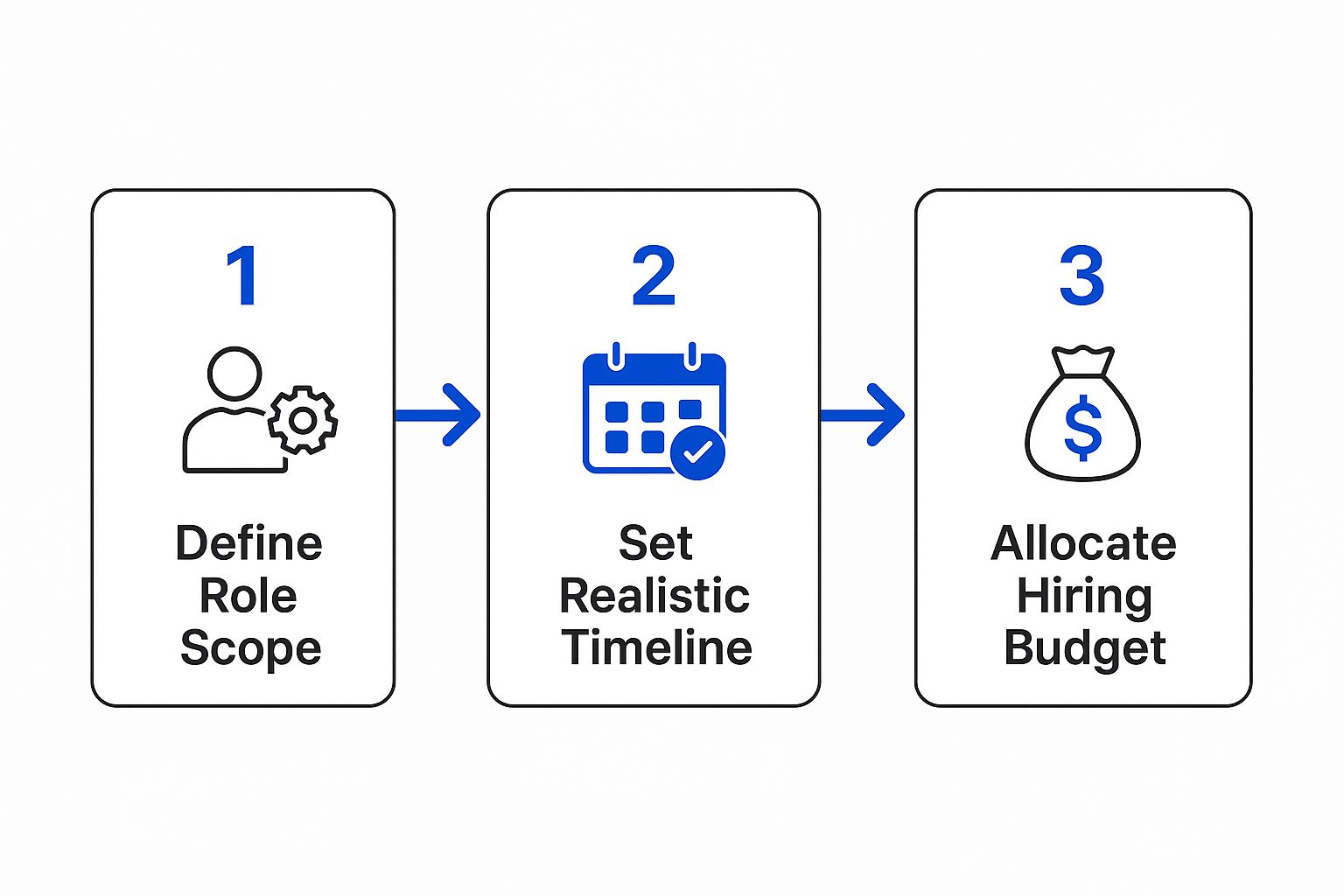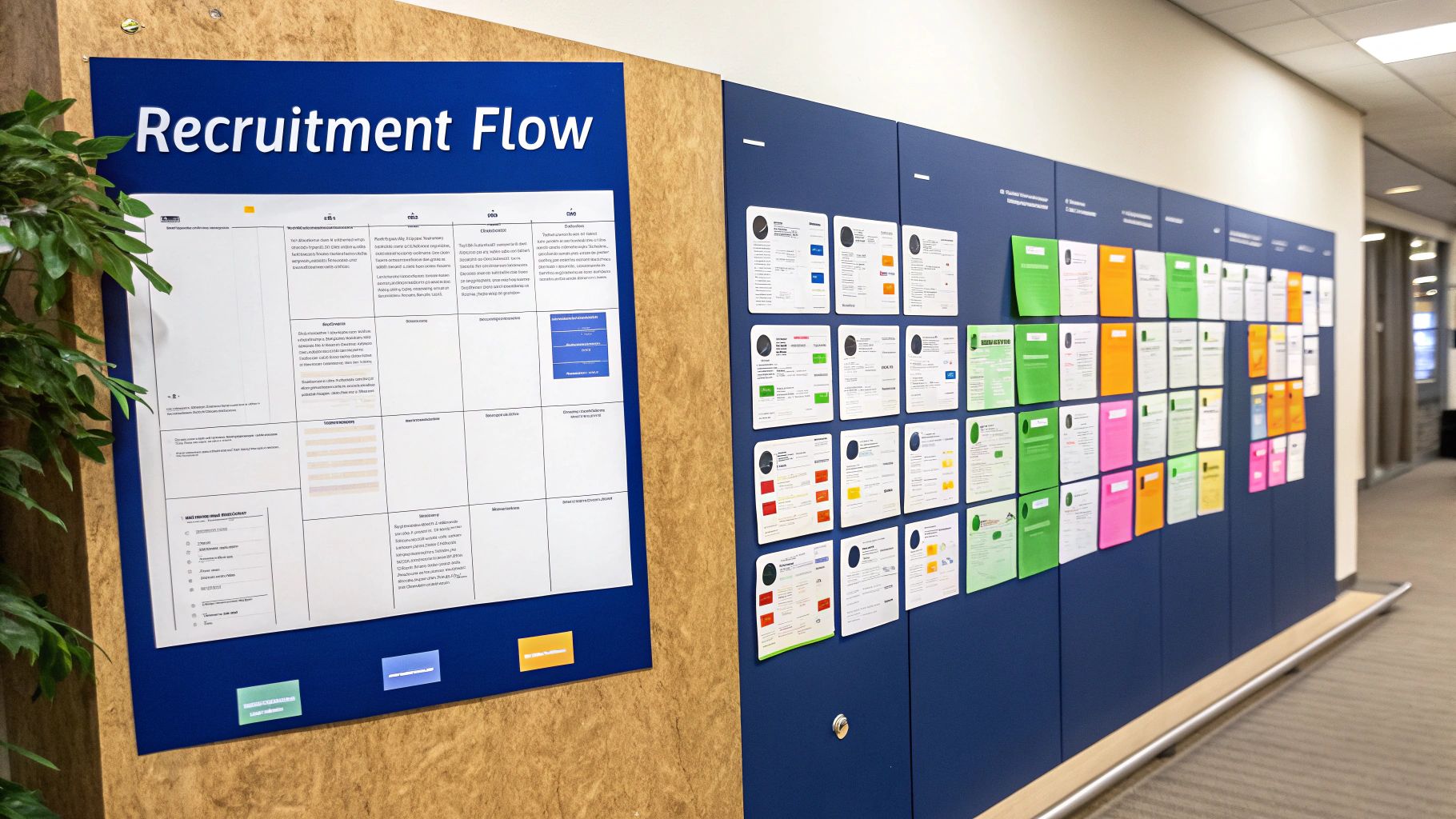So, what does it actually mean to apply project management to recruitment? At its core, it’s about taking the structured principles we use to build software or launch a marketing campaign—things like setting a clear scope, defining timelines, and managing resources—and applying them to the entire hiring journey.
It’s a complete mindset shift. Instead of seeing talent acquisition as a reactive, often frantic function, you start treating it as a strategic, predictable, and efficient operation. Every open role becomes a high-stakes project with a very clear, very important goal.
Why Your Hiring Is A High Stakes Project

Think back to the last time you had to make a critical hire. Was it a smooth, organised journey from start to finish? Or was it more of a mad dash to find someone—anyone—before a crucial deadline hit? If you’re like most organisations, it probably felt a lot like the latter. Hiring can easily feel like a jumble of disconnected tasks—sourcing, screening, interviewing—that can spiral out of control.
This is where the principles of project management in recruitment come in. They provide the scaffolding you need to stop the chaos before it starts. You’re no longer just "filling a role"; you're managing a complex project with one vital deliverable: bringing the right person onto your team.
The True Cost of Unstructured Hiring
An unstructured hiring process isn't just a bit messy; it's genuinely expensive. When roles sit empty for too long, productivity plummets, your existing team gets overworked, and you start missing out on real business opportunities.
Worse still, a rushed or disorganised process often leads to a bad hire. The financial hit from this can be staggering when you look into the true cost of employee turnover, which so often traces back to a flawed hiring project right at the beginning.
By treating each recruitment effort as a distinct project, you gain control over timelines, budgets, and outcomes. This approach ensures every stakeholder is aligned and every step is deliberate, directly leading to better hires in less time.
Key Elements of a Hiring Project
When you start framing recruitment as a project, you naturally begin to think about its core components. This simple shift in perspective forces everyone to get on the same page from day one, which dramatically increases your chances of success.
A well-managed hiring project always includes these four elements:
- Clear Goals: You need to define more than just a job title. What specific business problem will this new hire solve? What impact are they expected to make?
- Defined Timelines: Establish a realistic schedule with clear milestones for each stage, from posting the job ad to sending the final offer. This is what stops the process from dragging on.
- Identified Stakeholders: Get everyone involved—HR, the hiring manager, the interview panel—aligned on what an ideal candidate looks like and what their specific role in the process is.
- Allocated Resources: You need a clear budget. Account for expenses like job board postings, recruitment agency fees, or background checks to keep things financially predictable.
By embracing this way of working, you move from simply reacting to hiring needs to proactively managing them with the precision they deserve.
The Five Pillars of Recruitment Project Management
If you want to apply project management to your recruitment, you need a solid framework. Think of it like building a house – without strong pillars, the whole structure can come tumbling down. Mastering these five core elements is what turns a frantic, reactive hiring scramble into a proactive, organised, and predictable process.
These aren't just separate steps; they're interconnected parts of a machine. Get them all working together, and you'll find it much easier to manage expectations, control your resources, and consistently bring brilliant people on board.
Pillar 1: Scope Definition
First things first: you need to define your scope. This is the absolute foundation of your entire hiring project. Before you even think about writing a job description, you need to be crystal clear on what you’re actually trying to build.
This goes way beyond a simple job title. It’s about setting the boundaries and defining the real objective. What business problem is this new person going to solve? What are the absolute must-have skills, and what’s just nice to have?
For instance, hiring a software engineer isn't just about finding someone who "writes code." A proper scope would be much more specific, like "develop and maintain front-end features for our mobile app using React Native" and "collaborate with the product team to ship updates bi-weekly." Getting this right from the start prevents that dreaded "scope creep" – where the goalposts keep moving mid-search, causing endless delays and confusion.
Pillar 2: Timeline Management
Once you have a rock-solid scope, you can start building a realistic timeline. This pillar is all about mapping out the entire journey, from the moment the job is approved to the new hire's first day. A good timeline isn't just a guess; it sets clear milestones and deadlines for every single stage.
This simple act brings much-needed predictability to the hiring process and helps you manage everyone's expectations, especially the hiring manager's.
To build your timeline, you need to answer a few key questions:
- Sourcing: How long will we actively look for people and accept applications? (e.g., two weeks)
- Screening: What's our deadline for reviewing all the initial applications? (e.g., three working days after the closing date)
- Interviews: How much time will we block out for the first and final rounds? (e.g., one week per round)
- Offer Stage: How quickly do we need a decision once an offer is made? (e.g., 48-72 hours)
This infographic gives a great overview of the foundational flow, showing how a clear scope allows you to map out your timeline and budget.

As you can see, each pillar builds on the one before it, creating a logical sequence that you can follow for any hiring project.
Pillar 3: Budget and Resource Allocation
Every project runs on a budget, and hiring is no different. This pillar is about getting real about all the potential costs tied to making one hire. We’re talking about everything from job board ads and recruiter fees to background check services and even onboarding materials.
Having a defined budget stops you from overspending, but more importantly, it forces you to be strategic about where you look for candidates.
A well-managed recruitment budget isn't about spending less money; it's about spending it smarter. When you allocate funds thoughtfully, you can double down on the channels that actually deliver high-quality candidates, maximising your return on investment.
Pillar 4: Stakeholder Alignment
Your project team – or stakeholders – is everyone involved in the hire. That includes HR, the hiring manager, the interview panel, and sometimes even senior leadership. Getting everyone aligned is crucial for a smooth process.
Effective stakeholder alignment means everyone is on the same page about the role's scope, what the ideal candidate looks like, and what their specific job is in the process. Simple things like a weekly check-in meeting or a shared progress report can work wonders for keeping the project on track.
Pillar 5: Quality Assurance
Finally, the pillar that really defines success: quality. This isn't just about getting a bum in a seat. It's about delivering a fantastic candidate experience, making a successful hire who goes on to thrive in the role, and ultimately, solving the original business problem you set out to fix.
You can measure quality through things like candidate satisfaction surveys and time-to-hire stats. But the true test is the new hire's performance and how long they stay with the company, particularly within their first year. That’s the real bottom line.
To see how these principles work in practice, let's map them directly onto the typical recruitment stages.
Applying Project Management Principles to Recruitment Stages
The table below breaks down how these core project management ideas can be applied at each step of the hiring journey, turning abstract concepts into concrete actions.
By weaving these principles into your daily workflow, you transform recruitment from a series of disjointed tasks into a cohesive, strategic project with a clear beginning, middle, and end.
Mapping Your Recruitment Workflow Like A Pro

To really get to grips with project management in recruitment, you need to learn how to map your workflow. Think of it like this: no one would build a house without a blueprint, and you shouldn't start hiring without a clear plan. It’s all about breaking the entire journey down into distinct, manageable phases.
Let's walk through this process with a real-world example: hiring a new ‘Senior Marketing Manager’.
Visualising the process is a game-changer. Simple tools like a Kanban board—whether it’s a physical whiteboard with sticky notes or a digital tool like Trello—can be incredibly powerful. Each column represents a stage, and each candidate is a card that moves from left to right. This gives you a bird's-eye view of your entire pipeline, making it dead simple to see where candidates might be getting stuck.
Phase 1: Initiation and Planning
This is where it all kicks off. The project officially begins when a hiring manager submits a job requisition. Treat this document as the project’s business case; it clearly outlines why the role is needed and what a successful hire looks like. It’s your foundation.
Once that’s approved, you dive headfirst into planning. And no, this isn't just about quickly writing a job description. It’s about building a proper project plan.
- Sourcing Strategy: Where will you actually find these people? Define your key channels, whether that’s LinkedIn, niche job boards, or your employee referral programme.
- Interview Panel Design: Who needs to be in the room? Carefully select the interviewers for each stage and make sure they’re all on the same page about the evaluation criteria.
- Timeline and Milestones: Set clear, realistic deadlines for every stage of the process, from the application closing date to when you plan to make the final offer.
Phase 2: Execution and Monitoring
With a solid plan in your back pocket, you move into execution. This is the busy part of the project where you’re actively engaging with candidates and your internal team. It involves everything from screening CVs and conducting initial phone chats to scheduling interviews. Throughout this phase, communication is absolutely everything.
At the same time, you have to keep a close eye on your progress. Are you on track to meet your deadlines? Is the candidate pipeline looking healthy? Tracking key metrics like time-to-fill and source-of-hire lets you make smart, data-driven adjustments as you go. A well-organised workflow is a core component of building an efficient hiring process that gets results time and time again.
Monitoring isn't about micromanagement; it's about visibility. A clear view of your recruitment pipeline allows you to identify and resolve bottlenecks before they delay the entire project, ensuring a smoother journey for everyone involved.
Phase 3: Closure and Review
The final phase, closure, starts the moment you extend an offer. This part covers the negotiation, reference checks, and finally, getting that signed contract back. But don't pop the champagne just yet—the project isn’t quite finished. A successful closure also means providing a smooth transition into onboarding, setting your new hire up for success from their very first day.
Once your new team member has settled in, it's time for a post-project review. This step is crucial. Gather feedback from the hiring manager and the rest of the interview panel. What went well? What could be done better next time? This cycle of continuous improvement is what separates good recruiters from the great ones. To take your workflow to the next level, you might even consider adopting effective sales pipeline management strategies for tracking and moving candidates through your hiring funnel.
The Tangible Benefits of a Structured Hiring Process
Bringing a project management mindset to your recruitment efforts isn't just a theoretical exercise; it delivers real, measurable results for your business. When you start treating each hire like a well-defined project, you swap chaos for clarity, which leads to huge improvements across the board. It's a strategic shift that directly boosts your speed, quality, and bottom line.
One of the first things you’ll notice is a sharp drop in your time-to-hire. We’ve all seen it: CVs piling up in an inbox, interview feedback getting stuck, or key decision-makers going AWOL. A project-based approach anticipates these bottlenecks from the start, laying out a clear timeline with set milestones to cut out the dead time and keep everything moving.
Raising the Bar for Hire Quality and Candidate Experience
But it's not just about speed. A structured process fundamentally lifts the quality of hire. By using consistent tools like interview scorecards and holding proper kick-off meetings, you make sure every candidate is measured against the same objective standards. This data-first approach pushes personal bias aside and focuses on finding the best person for the role, not just the one who had a good day during the interview.
This consistency also builds a much better candidate experience. Applicants really value a process that’s transparent, communicative, and organised. When people know what to expect and get updates on time, it says great things about your company culture, making you an employer of choice even for those who don't get the offer. To push this even further, look at how tools involving AI in recruiting can add another layer of efficiency.
The Financial Case for Getting Organised
And finally, you can't ignore the numbers. A well-oiled hiring machine stops wasting resources. When recruiters and hiring managers spend less time on disorganised tasks, your internal costs go down. More importantly, you dramatically lower the risk of making a bad hire, which can be incredibly expensive in terms of lost productivity and the cost of starting all over again.
A structured hiring process is an investment in certainty. By controlling costs, improving outcomes, and strengthening your employer brand, you turn recruitment from a cost centre into a strategic driver of business growth.
The value of this structured, project-led approach is being recognised everywhere. Just look at the demand for skilled project managers themselves. A recent survey pointed out their average salary jumped by 10% to £52,500, with high levels of job satisfaction. As the full 2025 Salary and Market Trends Survey shows, this proves just how much businesses value project-based skills for hitting their goals.
Adapting Your Hiring Projects For Remote Teams
The shift to remote and hybrid work has completely rewritten the rulebook for talent acquisition. It's not just about where people work anymore; it's about fundamentally rethinking how we hire. When your team is spread out, a recruitment drive becomes a complex project with new challenges.
Suddenly, you're not just a recruiter; you're a project manager juggling time zones, digital communication tools, and a candidate experience that happens entirely through a screen. You can no longer pop down the hall to coordinate an interview. Every single step, from the first email to the final offer, needs to be planned with precision.
This new reality means your project plan needs to account for things we never used to worry about. Scheduling interviews turns into a strategic game of Tetris, often needing tools that can sync calendars across different continents. Every digital touchpoint matters immensely because it’s all the candidate sees of your company culture.
Mastering Remote Communication and Collaboration
In a remote environment, communication isn’t just important – it’s everything. You can’t rely on those casual hallway conversations to keep everyone on the same page. This is where sharp project management skills really come into play.
Your project plan must be incredibly deliberate about how and when the team communicates. You absolutely need a single, central place for all hiring information to live.
Create a Central Hub: Use a platform like Slack or Microsoft Teams to set up dedicated channels for each role. This keeps all conversations, candidate feedback, and important files neatly organised and accessible to the whole hiring team.
Schedule Regular Check-ins: A quick, daily 15-minute stand-up or a weekly sync meeting can work wonders. It ensures everyone knows where candidates are in the process and helps tackle any roadblocks before they cause serious delays.
When you can no longer manage by walking around, you must manage by creating clear, digital systems. A well-defined communication plan is the single most important factor in preventing delays and misunderstandings in a remote hiring project.
Building a Seamless Digital Candidate Journey
The onboarding stage of your hiring project also needs a complete overhaul. The aim is to make the digital welcome just as warm, engaging, and supportive as an in-person one. This means mapping out the onboarding journey with painstaking detail, making sure your new hire feels like part of the team from their very first day.
For a deeper dive, our guide offers detailed remote hiring strategies to help you flesh out this critical project phase.
Ultimately, successful project management in recruitment for remote teams is about being more intentional. It's about using technology not just to mimic old office habits, but to design smarter, more efficient workflows. The goal is a process that’s fair, engaging, and consistent for every single candidate, no matter where they are in the world.
Avoiding Common Recruitment Project Pitfalls

Let's be honest, bringing a new system into any process has its teething problems. When you start treating your hiring like a project, you'll find it’s no different. Even the most carefully planned recruitment drive can get sidetracked by a few common, and frankly frustrating, hurdles.
The good news? Once you know what to look for, you can steer clear of them completely.
One of the biggest culprits is scope creep. This is when the goalposts move halfway through the game. Imagine you've already started interviewing candidates for a role, and suddenly the hiring manager decides they absolutely must have a new skill that wasn't in the original brief. Just like that, you're back at the beginning.
Then there's the classic issue of poor stakeholder communication. If the hiring team isn't on the same page, everything slows down. Feedback gets lost, candidates are left in limbo, and all that initial momentum just evaporates. It's amazing how often a simple lack of a communication plan can cause so much chaos.
Building Your Defence Against Common Issues
So, how do you stop these problems from derailing your hard work? The key is to be proactive. You need to build your defences right into the project plan before you even post a job ad. These aren't complex, high-tech solutions—they're just good habits that keep everything on track.
To head off scope creep, for instance, you can lock in a ‘role definition document’ right at the start. Get every key stakeholder to sign off on it. This document becomes your North Star for the entire hiring process.
Think of your role definition document as the project's constitution. It clearly defines the objectives and boundaries, ensuring that any proposed changes must go through a formal review process rather than being made on a whim.
And to fix those communication breakdowns? Set a clear rhythm from day one. It could be a simple weekly 15-minute check-in or a dedicated Slack channel for the role. The important thing is that everyone knows where to get the latest information without having to chase people down.
Here are a few more practical fixes for problems we see all the time:
The Pitfall: Throwing technology at the problem. A shiny new Applicant Tracking System can't fix a fundamentally broken process.
The Solution: Map your ideal workflow first. Only then should you look for the tools that fit how you want to work, not the other way around.
The Pitfall: Confusion over who does what. "I thought you were screening those CVs?" is a phrase you never want to hear.
The Solution: Define everyone's role in your initial project plan. Make it crystal clear who is responsible for each stage, from screening to making the final offer.
By thinking ahead and anticipating these challenges, you can weave the solutions directly into your workflow. What could have been a project-ending disaster becomes nothing more than a minor bump in the road.
Answering Your Questions About Recruitment Project Management
Adopting a more structured approach to hiring always brings up a few practical questions. Let's tackle some of the most common ones that come up when teams start applying project management to their recruitment.
What are the Best Tools for Recruitment Project Management?
There isn’t a single "best" tool that fits everyone; the right choice really boils down to your team's size, your budget, and how you like to work. For many, simple and visual is the way to go.
Kanban Boards: Think of tools like Trello or Asana. They are brilliant for seeing your entire hiring pipeline at a glance. You can set up columns for each stage—like Sourcing, Screening, and Interviewing—and simply drag candidate cards from one stage to the next. It’s intuitive and keeps everyone on the same page.
Applicant Tracking Systems (ATS): A dedicated ATS, such as Workable or Greenhouse, is the next step up. These platforms often come with project management features baked right in, letting you track key metrics, automate interview scheduling, and keep all candidate communication in one tidy place.
The secret is to pick a tool that your team will genuinely use every day. It's often better to start with something simple and only introduce more complex features as you find you actually need them.
How Can Small Businesses Apply This Without a Project Manager?
You absolutely don't need to hire a dedicated Project Manager to reap the rewards. At its heart, project management in recruitment is a way of thinking and working, not just a job title.
For smaller businesses, the hiring manager or even a senior team member can easily step in as the informal project lead. Their job is to make sure the fundamentals are covered: the role is clearly defined, a sensible timeline is agreed upon, and everyone involved in the hiring process understands what they need to do and when.
The point isn't to create red tape; it's to bring much-needed clarity and organisation. For a small team, even a simple shared document that maps out the hiring plan and key dates can make an enormous difference.
How Do You Measure the ROI of a Structured Process?
Proving the value of this structured approach comes down to measuring your return on investment (ROI). The best way to do this is to track a few key metrics, both before and after you introduce these project management disciplines.
Time-to-Hire: This is a big one. If you can significantly shorten the time it takes to fill a role, you get a new team member contributing to the business much sooner.
Cost-per-Hire: Keep an eye on your spending. A more efficient process often means spending less on things like extended job board listings or recruitment agency fees.
Quality of Hire: This is the ultimate test. Look at the performance reviews and retention rates of new starters after their first six and twelve months. A noticeable drop in early turnover is a powerful sign that your hiring projects are hitting the mark.

